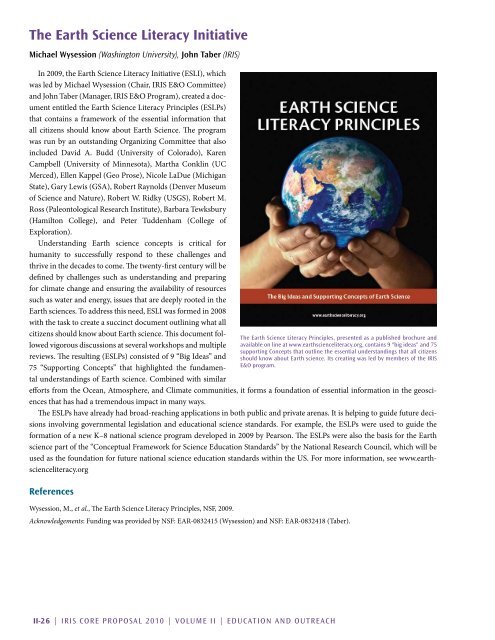Accomplishments - IRIS
Accomplishments - IRIS
Accomplishments - IRIS
You also want an ePaper? Increase the reach of your titles
YUMPU automatically turns print PDFs into web optimized ePapers that Google loves.
The Earth Science Literacy Initiative<br />
Michael Wysession (Washington University), John Taber (<strong>IRIS</strong>)<br />
In 2009, the Earth Science Literacy Initiative (ESLI), which<br />
was led by Michael Wysession (Chair, <strong>IRIS</strong> E&O Committee)<br />
and John Taber (Manager, <strong>IRIS</strong> E&O Program), created a document<br />
entitled the Earth Science Literacy Principles (ESLPs)<br />
that contains a framework of the essential information that<br />
all citizens should know about Earth Science. The program<br />
was run by an outstanding Organizing Committee that also<br />
included David A. Budd (University of Colorado), Karen<br />
Campbell (University of Minnesota), Martha Conklin (UC<br />
Merced), Ellen Kappel (Geo Prose), Nicole LaDue (Michigan<br />
State), Gary Lewis (GSA), Robert Raynolds (Denver Museum<br />
of Science and Nature), Robert W. Ridky (USGS), Robert M.<br />
Ross (Paleontological Research Institute), Barbara Tewksbury<br />
(Hamilton College), and Peter Tuddenham (College of<br />
Exploration).<br />
Understanding Earth science concepts is critical for<br />
humanity to successfully respond to these challenges and<br />
thrive in the decades to come. The twenty-first century will be<br />
defined by challenges such as understanding and preparing<br />
for climate change and ensuring the availability of resources<br />
such as water and energy, issues that are deeply rooted in the<br />
Earth sciences. To address this need, ESLI was formed in 2008<br />
with the task to create a succinct document outlining what all<br />
citizens should know about Earth science. This document followed<br />
vigorous discussions at several workshops and multiple<br />
reviews. The resulting (ESLPs) consisted of 9 “Big Ideas” and<br />
75 “Supporting Concepts” that highlighted the fundamental<br />
understandings of Earth science. Combined with similar<br />
efforts from the Ocean, Atmosphere, and Climate communities, it forms a foundation of essential information in the geosciences<br />
that has had a tremendous impact in many ways.<br />
The ESLPs have already had broad-reaching applications in both public and private arenas. It is helping to guide future decisions<br />
involving governmental legislation and educational science standards. For example, the ESLPs were used to guide the<br />
formation of a new K–8 national science program developed in 2009 by Pearson. The ESLPs were also the basis for the Earth<br />
science part of the “Conceptual Framework for Science Education Standards” by the National Research Council, which will be<br />
used as the foundation for future national science education standards within the US. For more information, see www.earthscienceliteracy.org<br />
References<br />
The Earth Science Literacy Principles, presented as a published brochure and<br />
available on line at www.earthscienceliteracy.org, contains 9 "big ideas" and 75<br />
supporting Concepts that outline the essential understandings that all citizens<br />
should know about Earth science. Its creating was led by members of the <strong>IRIS</strong><br />
E&O program.<br />
Wysession, M., et al., The Earth Science Literacy Principles, NSF, 2009.<br />
Acknowledgements: Funding was provided by NSF: EAR-0832415 (Wysession) and NSF: EAR-0832418 (Taber).<br />
II-26 | <strong>IRIS</strong> Core Proposal 2010 | Volume II | education and outreach

















